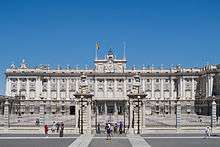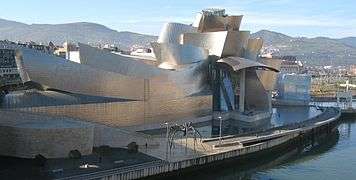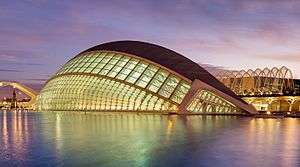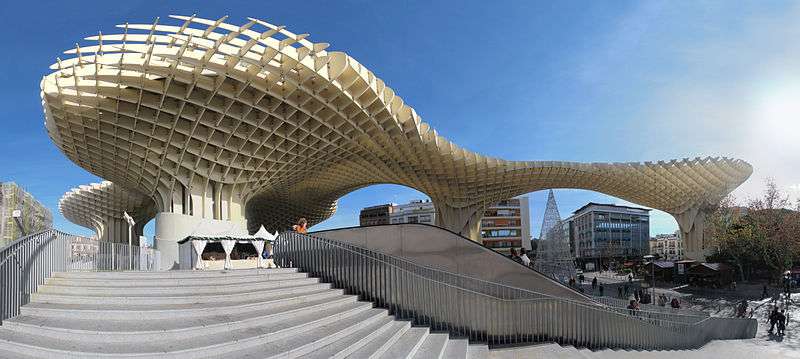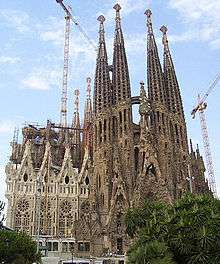Spanish architecture

Spanish architecture refers to architecture carried out in any area in what is now Spain, and by Spanish architects worldwide. The term includes buildings within the current geographical limits of Spain before this name was given to those territories (whether they were called Iberia, Hispania, Al-Andalus or were formed of several Christian kingdoms). Due to its historical and geographical diversity, Spanish architecture has drawn from a host of influences.[1] Iberian architecture started to take shape in parallel with other architectures around the Mediterranean and others from Northern Europe.
A real development came with the arrival of the Romans, who left behind some of their most outstanding monuments in Hispania. The arrival of the Visigoths brought about a profound decline in building techniques which was paralleled in the rest of the former Empire. The Moorish conquest in 711 CE lead to a radical change and for the following eight centuries there were great advances in culture, including architecture. For example, Córdoba was established as the cultural Capital of its time under the Muslim Umayyad dynasty. Simultaneously, the Christian kingdoms gradually emerged and developed their own styles, at first mostly isolated from European architectural influences, and later integrated into Romanesque and Gothic streams, they reached an extraordinary peak with numerous samples along the whole territory. The Mudéjar style, from the 12th to 17th centuries, was characterised by the blending of cultural European and Arabic influences.
Towards the end of the 15th century, and before influencing Latin America with its Colonial architecture, Spain itself experimented with Renaissance architecture, developed mostly by local architects. Spanish Baroque was distinguished by its exuberant Churrigueresque decoration and the most sober Herrerian style, both developing separately from later international influences. The Colonial style, which has lasted for centuries, still has a strong influence in Latin America. Neoclassicism reached its peak in the work of Juan de Villanueva and his disciples.
The 19th century had two faces: the engineering efforts to achieve a new language and bring about structural improvements using iron and glass as the main building materials, and the academic focus, firstly on revivals and eclecticism, and later on regionalism. The arrival of Modernism in the academic arena produced figures such as Gaudí and much of the architecture of the 20th century. The International style was led by groups like GATEPAC. Spain is currently experiencing a revolution in contemporary architecture and Spanish architects like Rafael Moneo, Santiago Calatrava, Ricardo Bofill as well as many others have gained worldwide renown.
Because of their artistic relevance, many architectural sites in Spain, and even portions of cities, have been designated World Heritage sites by UNESCO. Spain has the second highest number of World Heritage Sites in the world; only Italy has more. These are listed at List of World Heritage Sites in Europe: Spain.
Prehistory
Megalithic architecture
In the Stone Age, the most expanded megalith in the Iberian Peninsula was the dolmen. The plans of these funerary chambers used to be pseudocircles or trapezoids, formed by huge stones stuck on the ground, and others over them, forming the roof. As the typology evolved, an entrance corridor appeared, and gradually took prominence and became almost as wide as the chamber. Roofed corridors and false domes were common in the most advanced stage. The complex of Antequera contains the largest dolmens in Europe. The best preserved, the Cueva de Menga, is twenty-five metres deep and four metres high, and was built with thirty-two megaliths.
The best preserved examples of architecture from the Bronze Age are located in the Balearic Islands, where three kinds of construction appeared: the T-shaped taula, the talayot and the naveta. The talayots were troncoconical or troncopiramidal defensive towers. They used to have a central pillar. The navetas, were constructions made of great stones and their shape was similar to a ship hull.
Iberian and Celtic architecture

The most characteristic constructions of the Celts were the Castros, walled villages usually on the top of hills or mountains. They were developed at the areas occupied by the Celts in the Duero valley and in Galicia. Examples include Las Cogotas, in Ávila and the Castro of Santa Tecla, in Pontevedra.
The houses inside the Castros are about 3.5 to 5 meters long, mostly circular with some rectangular, stone-made and with thatch roofs which rested on a wood column in the centre of the building. Their streets are somewhat regular, suggesting some form of central organization.
The towns built by the Arévacos were related to Iberian culture, and some of them reached notable urban development like Numantia. Others were more primitive and usually excavated into the rock, like Termantia.
Roman period
Urban development

The Roman conquest of Hispania, started in 218 BC supposed the almost complete romanization of the Iberian Peninsula. Roman culture was deeply assumed by local population: Former military camps and Iberian, Phoenician and Greek settlements were transformed in large cities where urbanization highly developed in the provinces: Emerita Augusta in the Lusitania, Corduba, Italica, Hispalis, Gades in the Baetica, Tarraco, Caesar Augusta, Asturica Augusta, Legio Septima Gemina and Lucus Augusti in the Tarraconensis were some of the most important cities, linked by a complex net of roads. The construction development includes some monuments of comparable quality to those of the capital, Rome.[2]
Constructions
Civil engineering represented in imposing constructions like the Aqueduct of Segovia or Mérida (acueducto de los Milagros), in bridges like Alcántara Bridge and Mérida bridge, over Tagus River, or Córdoba bridge, over Guadalquivir River. Civil works were widely developed in Hispania under Emperor Trajan (98-117 AD). Lighthouses like the one still in use Hercules Tower, in La Coruña, were also built.
Ludic architecture is represented by such buildings as the theaters of Mérida, Sagunto or Tiermes, the amphitheaters like the ones in Mérida, Italica, Tarragona or Segobriga and circuses were built in Mérida, Córdoba, Toledo, Sagunto and many others.
Religious architecture also spread thougout the Peninsula: examples include the temples of Córdoba, Vic, Mérida (Diana and Mars), and Talavera la Vieja, among others. The main funerary monuments are the Escipiones tower of Tarragona, the distyle of Zalamea de la Serena in Badajoz, and the Mausoleums of the Atilii family, in Sádaba and of Fabara, in Ampurias, both in Zaragoza. Arches of the Triumph can be found in Cáparra (four faced), Bará and Medinaceli.
Pre-Romanesque period
The term Pre-Romanesque refers to the Christian art after the Classical Age and before Romanesque art and architecture. It cover very heterogeneous artistic displays for they were developed in different centuries and by different cultures. Spanish territory boasts a rich variety of Pre-Romanesque architecture: some of its branches, like the Asturian art reached high levels of refinement for their era and cultural context.
Visigothic architecture
Asturian art
The kingdom of Asturias arose in 718, when the Astur tribes, rallied in assembly, decided to appoint Pelayo as their leader. Pelayo joined the local tribes and the refuged Visigoths under his command, with the intention of progressively restoring Gothic Order.
Asturian Pre-Romanesque is a singular feature in all Spain, which, while combining elements from other styles as Visigothic and local traditions, created and developed its own personality and characteristics, reaching a considerable level of refinement, not only as regards construction, but also in terms of aesthetics.
As regards its evolution, from its appearance, Asturian Pre-Romanesque followed a "stylistic sequence closely associated with the kingdom's political evolution, its stages clearly outlined". It was mainly a court architecture, and five stages are distinguished; a first period (737-791) from the reign of the king Fáfila to Vermudo I. A second stage comprises the reign of Alfonso II (791-842), entering a stage of stylistic definition. These two first stages receive the name of Pre-Ramirense. Its most important church is San Julián de los Prados, in Oviedo, with an interesting volumetry and a complex iconographical frescoes program, related narrowly to the Roman mural paintings. The characteristic lattices and the triple window at the chevet appeared first at this stage. The Holy Chamber of the Cathedral of Oviedo, San Pedro de Nora and Santa María de Bendones also belong to it.
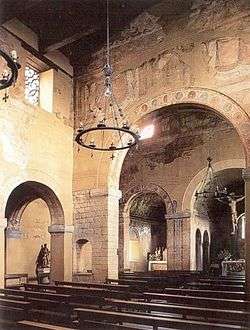
The third period comprises the reigns of Ramiro I (842-850) and Ordoño I (850-866). It is called Ramirense and is considered the zenith of the style, due to the work of an unknown architect who brought new structural and ornamental achievements like the barrel vault, and the consistent use of transverse arches and buttresses, which made the style rather close to the structural achievements of the Romanesque two centuries later. Some writers have pointed to an unexplained Syrian influence of the rich ornamentation. In that period most of the masterpieces of the style flourished: The palace pavilions of Naranco Mountain (Santa Maria del Naranco and San Miguel de Lillo) and the church of Santa Cristina de Lena were built in that period.
The fourth period belongs to the reign of Alfonso III (866-910), where a strong Mozarab influence arrived to Asturian architecture, and the use of the horse-shoe arch expanded. A fifth and last which coincides with the transfer of the court to León, the disappearance of the kingdom of Asturias, and simultaneously, of Asturian Pre-Romanesque.
Repopulation architecture
From the ending of the 9th to the beginning of the 11th century a number of churches were built in the Northern Christian kingdoms. They are widely but incorrectly known as Mozarabic architecture. This architecture is a summary of elements of diverse extraction irregularly distributed, of a form that in occasions predominate those of paleo-Christian, Visigothic or Asturian origin, while at other times emphasizes the Muslim impression.
The churches have usually basilica or centralized plans, sometimes with opposing apses. Principal chapels are of rectangular plan on the exterior and ultra-semicircular in the interior. The horseshoe arch of Muslim evocation is used, somewhat more closed and sloped than the Visigothic as well as the alfiz. Geminated and tripled windows of Asturian tradition and grouped columns forming composite pillars, with Corinthian capital decorated with stylized elements.
Decoration has resemblance to the Visigothic based in volutes, swastikas, and vegetable and animal themes forming projected borders and sobriety of exterior decoration. Some innovations are introduced, as great lobed corbels that support very pronounced eaves.
A great command of the technique in construction can be observed, employing ashlar, walls reinforced by exterior buttresses and covering by means of segmented vaults, including by the traditional barrel vaults.
The architecture of Al-Andalus
The Caliphate of Córdoba

The Moorish conquest of the former Hispania by the troops of Musa ibn Nusair and Tariq ibn Ziyad, and the overthrowing of the Umayyad dynasty in Damascus, led to the creation of an independent Emirate by Abd ar-Rahman I, the only surviving prince who escaped from Abbasids, and established his capital city in Córdoba. It was to become the cultural capital of Occident from 750 to 1009. The architecture built in Al-Ándalus under the Umayyads evolved from the architecture of Damascus with the addition of aesthetic achievements of local influence: the horse-shoe arch, a distinctive of Spanish Arab architecture was taken from Visigoths. Architects, artists and craftsmen came from the Orient to construct cities like Medina Azahara whose splendour couldn't have been imagined by the European kingdoms of the era.[3]
The most outstanding construction of the Umayyad Córdoba is the Great Mosque, built in consecutive stages by Abd ar-Rahman I, Abd ar-Rahman II, Al-Hakam II and Al-Mansur.
The Taifas
The Caliphate disappeared and was split into several small kingdoms called Taifas. Their political weakness was accompanied by a cultural retreat, and together with a quick advance of the Christian kingdoms, the taifas clung to the prestige of structures and forms of the style of Córdoba. The recession was felt in the construction techniques and in the materials, though not in the profusion of the ornamentation. The lobes of multifoil arches were multiplied and thinned, transformed in lambrequins, and all the Caliphal elements were exaggerated. Some magnificent examples of the Taifa architecture have reached our times, like the Palace of the Aljafería, in Zaragoza, or the small mosque of Bab-Mardum, in Toledo, later transformed into one of the first examples of Mudéjar architecture (Cristo de la Luz hermitage).
Almoravids and Almohads

The Almoravids invaded Al-Andalus from north Africa in 1086, and unified the taifas under their power. They developed their own architecture, but very little of it remains because of the next invasion, that of the Almohads, who imposed Islamic ultra-orthodoxy and destroyed almost every significant Almoravid building, together with Medina Azahara and other Caliphate constructions. Their art was extremely sober and bare, and they used brick as their main material. Virtually their only superficial decoration, the sebka, is based in a grid of rhombuses. The Almohads also used palm decoration, but this was nothing more than a simplification of the much more decorated Almoravid palm. As time passed, the art became slightly more decorative. The best known piece of Almohad architecture is the Giralda, the former minaret of the Mosque of Seville. Classified as Mudéjar, but immersed in the Almohad aesthetic, the synagogue of Santa María la Blanca, in Toledo, is a rare example of architectural collaboration between the three cultures of Medieval Spain.
Nasrid architecture of the Kingdom of Granada

After the dissolution of the Almohad empire, the scattered Moorish kingdoms of the south of the Peninsula were reorganized, and in 1237, the Nasrid kings established their capital city in Granada. The architecture they produced was to be one of the richest produced by Islam in any period. This owed a great deal to the cultural heritage of the former Moorish styles of Al-Ándalus, that the Nasrids eclectically combined, and to the close contact with the northern Christian Kingdoms. The palaces of Alhambra and the Generalife are the most outstanding constructions of the period. The structural and ornamental elements were taken from Cordobese architecture (horse-shoe arches), from Almohads (sebka and palm decoration), but also created by them, like the prism and cylindrical capitals and mocárabe arches, in a gay combination of interior and exterior spaces, of gardening and architecture, that aimed to please all the senses. Unlike the Umayyad architecture, which made use of expensive and imported materials, the Nasrids used only humble materials: clay, plaster and wood. However, the aesthetic outcome is full of complexity and is mystifying for the beholder: The multiplicity of decoration, the skillful use of light and shadow and the incorporation of water into the architecture are some of the keys features of the style.[4] Epigraphy was also used on the walls of the different rooms, with allusive poems to the beauty of the spaces.[5]
Mudéjar Style

The architecture of the Moors and native Andalusians who remained in Christian territory but were not converted to Christianity is called Mudéjar Style. It developed mainly from 12th to 16th centuries and was strongly influenced by Moorish taste and workmanship but constructed for the use of Christian owners. Thus, it is not really a pure style: Mudéjar architects frequently combined their techniques and artistic language with other styles, depending of the historical moment. Thus we can refer to Mudéjar, but also to Mudéjar-Romanesque, Mudéjar-Gothic or Mudéjar-Renaissance.
The Mudéjar style, a symbiosis of techniques and ways of understanding architecture resulting from Jewish, Muslim and Christian cultures living side by side, emerged as an architectural style in the 12th century. It is characterised by the use of brick as the main building material. Mudéjar did not involve the creation of new structures (unlike Gothic or Romanesque), but reinterpreting Western cultural styles through Islamic influences. The dominant geometrical character, distinctly Islamic, emerged conspicuously in the accessory crafts using cheap materials elaborately worked—tilework, brickwork, wood carving, plaster carving, and ornamental metals. Even after the Muslims were no longer employed, many of their contributions remained an integral part of Spanish architecture.
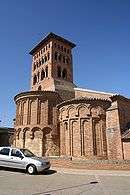
It is accepted that the Mudéjar style was born in Sahagún.[6] Mudéjar extended to the rest of the Kingdom of León, Toledo, Ávila, Segovia, and later to Andalusia, especially Seville and Granada. The Mudéjar Rooms of the Alcázar of Seville, although classified as Mudéjar, are more closely related to the Nasrid Alhambra than to other buildings of the style as they were created by Pedro of Castile, who brought architects from Granada who experienced very little Christian influence. Centers of Mudéjar art are found in other cities, like Toro, Cuéllar, Arévalo and Madrigal de las Altas Torres. It became highly developed in Aragon, with 3 main focuses: Zaragoza, Calatayud, and Teruel, during the 13th, 14th and 15th centuries. In Teruel a wide group of imposing churches and towers were built. Other fine examples of Mudéjar can be found in Casa Pilatos (Seville), Santa Clara Monastery, in Tordesillas, or the churches of Toledo, one of the oldest and most outstanding Mudéjar centers. In Toledo, the synagogues of Santa María la Blanca and El Tránsito (both Mudéjar though not Christian) deserve special mention.[7]
Romanesque period

- See also: Characteristics of Romanesque churches in Spain, Portugal and Andorra and Romanesque architecture in Spain
Romanesque first developed in Spain in the 10th and 11th centuries, before Cluny`s influence, in Lérida, Barcelona, Tarragona and Huesca and in the Pyrenees, simultaneously with the north of Italy, as what is called "First Romanesque" or "Lombard Romanesque". It is a very primitive style, whose characteristics are thick walls, lack of sculpture and the presence of rhythmic ornamental arches, typified by the churches in the Valle de Bohí.
The full Romanesque architecture arrived with the influence of Cluny through the Way of Saint James, that ends in the Cathedral of Santiago de Compostela. The model of the Spanish Romanesque in the 12th century was the Cathedral of Jaca, with its characteristic plan and apse, and its "chessboard" decoration in stripes, called taqueado jaqués. As the Christian Kingdoms advanced southwards, this model spread throughout the reconquered areas with some variations. Spanish Romanesque also shows the influence of Spanish pre-Romanesque styles, mainly Asturian and Mozarabic. But there is also a strong Moorish influence, especially the vaults of Córdoba's Mosque, and the multifoil arches. In the 13th century, some churches alternated in style between Romanesque and Gothic. Aragón, Navarra and Castile-Leon are some of the best areas for Spanish Romanesque architecture.
The Gothic period
The gothic style arrived in Spain as a result of European influence in the 12th century when late Romanesque alternated with a few expressions of pure Gothic architecture like the Cathedral of Ávila. The High Gothic arrived in all its strength through the Way of Saint James in the 13th century, with some of the purest Gothic cathedrals, with German and French influence: the cathedrals of Burgos, León and Toledo.
The most important post-13th century Gothic styles in Spain are the Levantino and Isabelline Gothic. Levantino Gothic is characterised by its structural achievements and their unification of space, with masterpieces as La Seu (cathedral) in Palma de Mallorca, Valencia's silk market, (Lonja de Valencia), and Santa Maria del Mar (Barcelona).
Isabelline Gothic, created during the times of the Catholic Monarchs, was part of the transition to Renaissance architecture, but also a strong resistance to Italian Renaissance style. Highlights of the style include Saint John of The Kings in Toledo and the Royal Chapel of Granada.
Renaissance

In Spain, Renaissance began to be grafted to Gothic forms in the last decades of the 15th century. The style started to spread made mainly by local architects: that is the cause of the creation of a specifically Spanish Renaissance, that brought the influence of South Italian architecture, sometimes from illuminated books and paintings, mixed with gothic tradition and local idiosyncrasy. The new style was called Plateresque, because of the extremely decorated façades, that brought to the mind the decorative motifs of the intricately detailed work of silversmiths, the "Plateros". Classical orders and candelabra motifs (a candelieri) were combined freely into symmetrical wholes.
In that scenery, the Palace of Charles V by Pedro Machuca, in Granada, supposed an unexpected achievement in the most advanced Renaissance of the moment. The palace can be defined as an anticipation of the Mannerism, due to its command of the classical language and its rupturist aesthetical achievements. It was constructed before the main works of Michelangelo and Palladio . Its influence was very limited, and, misunderstood, Plateresque forms imposed in the general panorama.
As decades passed, the gothic influence disappeared and the research of an orthodox classicism reached high levels. Although Plateresco is a commonly used term to define most of the architectural production of the late XV and first half of XVI, some architects acquired a more sober personal style, like Diego Siloe and Rodrigo Gil de Hontañón.
Examples include the façades of the University of Salamanca and of the Convent of San Marcos in León.
The highlight of Spanish Renaissance is represented by the Royal Monastery of El Escorial, made by Juan Bautista de Toledo and Juan de Herrera where a much closer adherence to the art of ancient Rome was overpassed by an extremely sober style. The influence from Flanders roofs, the symbolism of the scarce decoration and the precise granite cut were established as the basis of a new style that would influence Spanish architecture for a century: Herrerian. A disciple of Herrera, Juan Bautista Villalpando was influential for interpreting the recently revived text of Vitruvius to suggest the origin of the classical orders in Solomon's Temple.[8]
Baroque period
As Italian Baroque influences penetrated across the Pyrenees, they gradually superseded in popularity the restrained classicizing approach of Juan de Herrera, which had been in vogue since the late sixteenth century. As early as 1667, the façades of Granada Cathedral (by Alonso Cano) and Jaén Cathedral (by Eufrasio López de Rojas) suggest the artists' fluency in interpreting traditional motifs of Spanish cathedral architecture in the Baroque aesthetic idiom.
Vernacular Baroque with its roots still in Herrera and in traditional brick construction was developed in Madrid throughout the 17th century. Examples include Plaza Mayor and the Major House.
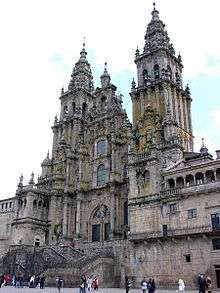
In contrast to the art of Northern Europe, the Spanish art of the period appealed to the emotions rather than seeking to please the intellect. The Churriguera family, which specialized in designing altars and retables, revolted against the sobriety of the Herreresque classicism and promoted an intricate, exaggerated, almost capricious style of surface decoration known as the Churrigueresque. Within half a century, they transformed Salamanca into an exemplary Churrigueresque city.
The evolution of the style passed through three phases. Between 1680 and 1720, the Churriguera popularized Guarini's blend of Solomonic columns and composite order, known as the "supreme order". Between 1720 and 1760, the Churrigueresque column, or estipite, in the shape of an inverted cone or obelisk, was established as a central element of ornamental decoration. The years from 1760 to 1780 saw a gradual shift of interest away from twisted movement and excessive ornamentation toward a neoclassical balance and sobriety.
Two of the most eye-catching creations of Spanish Baroque are the energetic façades of the University of Valladolid (Diego Tomé, 1719) and Hospicio de San Fernando in Madrid (Pedro de Ribera, 1722), whose curvilinear extravagance seems to herald Antonio Gaudí and Art Nouveau. In this case as in many others, the design involves a play of tectonic and decorative elements with little relation to structure and function. However, Churrigueresque baroque offered some of the most impressive combinations of space and light with buildings like Granada Charterhouse, considered to be the apotheosis of Churrigueresque styles applied to interior spaces, or the Transparente of the Cathedral of Toledo, by Narciso Tomé, where sculpture and architecture are integrated to achieve notable light dramatic effects.
The Royal Palace of Madrid and the interventions of Paseo del Prado (Salón del Prado and Alcalá Doorgate) in the same city, deserve special mention. They were constructed in a sober Baroque international style, often mistaken for neoclassical, by the Bourbon kings Philip V and Charles III. The Royal Palaces of La Granja de San Ildefonso, in Segovia, and Aranjuez, in Madrid, are good examples of baroque integration of architecture and gardening, with noticeable French influence (La Granja is known as the Spanish Versailles), but with local spatial conceptions which in some ways display the heritage of the Moorish occupation.
Rococo was first introduced to Spain in the (Cathedral of Murcia, west façade, 1733). The greatest practitioner of the Spanish Rococo style was a native master, Ventura Rodríguez, responsible for the dazzling interior of the Basilica of Our Lady of the Pillar in Zaragoza (1750).
Spanish Colonial architecture
The combination of the Native American and Moorish decorative influences with an extremely expressive interpretation of the Churrigueresque idiom may account for the full-bodied and varied character of the Baroque in the American colonies of Spain. Even more than its Spanish counterpart, American Baroque developed as a style of stucco decoration. Twin-towered façades of many American cathedrals of the seventeenth century had medieval roots and the full-fledged Baroque did not appear until 1664, when the Jesuit shrine on Plaza des Armas in Cusco was built.
The Peruvian Baroque was particularly lush, as evidenced by the monastery of San Francisco in Lima (1673), which has a dark intricate façade sandwiched between the twin towers of local yellow stone. While the rural Baroque of the Jesuite missions (estancias) in Córdoba, Argentina, followed the model of Il Gesù, provincial "mestizo" (crossbred) styles emerged in Arequipa, Potosí and La Paz. In the eighteenth century, the architects of the region turned for inspiration to the Mudéjar art of medieval Spain. The late Baroque type of Peruvian façade first appears in the Church of Our Lady of La Merced, Lima (1697–1704). Similarly, the Church of La Compañia, Quito (1722–65) suggests a carved altarpiece with its richly sculpted façade and a surfeit of spiral salomónica.
To the north, the richest province of 18th-century New Spain — Mexico — produced some fantastically extravagant and visually frenetic architecture known as New Spanish Churrigueresque. This ultra-Baroque approach culminates in the works of Lorenzo Rodríguez, whose masterpiece is the Sagrario Metropolitano in Mexico City (1749–69). Other fine examples of the style may be found in the remote silver-mining towns. For instance, the Sanctuary at Ocotlán (begun in 1745) is a top-notch Baroque cathedral surfaced in bright red tiles, which contrast delightfully with a plethora of compressed ornament lavishly applied to the main entrance and the slender flanking towers.
The true capital of New Spanish Baroque is Puebla, Puebla, where a ready supply of hand-painted glazed tiles (talavera) and vernacular gray stone led to its evolving further into a personalised and highly localised art form with a pronounced Indian flavour.
Neoclassical Style
.jpg)
The extremely intellectual postulates of Neoclassicism succeeded in Spain less than the much more expressive of Baroque. Spanish Neoclassicism was spread by the Royal Academy of Fine Arts of San Fernando, founded in 1752. The main figure was Juan de Villanueva, who adapted Burke's achievements about the sublime and the beauty to the requirements of Spanish clime and history. He built the Prado Museum, that combined three programs- an academy, an auditorium and a museum- in one building with three separated entrances. This was part of the ambitious program of Charles III, who intended to make Madrid the Capital of Art and Science. Very close to the museum, Villanueva built the Astronomical Observatory. He also designed several summer houses for the kings in El Escorial and Aranjuez and reconstructed the Major Square of Madrid, among other important works. Villanuevas´ pupils Antonio López Aguado and Isidro González Velázquez spread the Neoclassical style through the center of the country.
19th century
Eclecticism and Regionalism
During the second half of the 19th century, the architectural revivals dominated the scene in Europe, and so happened in Spain. Architects focused in choosing which was the most appropriated historical style for each use or occasion. Neoclassicism opened the gates to Neo-Gothic, Neo-Egyptian, Neo-Byzantine, Neo-Romanesque, and so on. This all led to a particular new style made of the mixture of several old styles in the same construction: the Eclecticism. It is difficult to trace a clear line to separate styles as Modernisme, Industrial iron architecture and Eclecticism, as very often architects took some features of several of them for their works. This is the case of Antonio Palacios, co-designer with Joaquín Otamendi of the Communications Palace of Madrid (Palacio de Comunicaciones de Madrid), inaugurated in 1909.

Other works of Palacios include the Circle of Fine Arts, the Río de la Plata Bank, the Hospital of Laborers, all of them in Madrid.
In the first half of the 20th century, another wave of revivals emerged, mainly after the Iberoamerican Exhibition of Seville in 1929: the Regionalisms. Features of the different regional vernacular architectures took then the protagonism.
Neo-Mudéjar Style
In the late 19th century a new architectural movement emerged in Madrid as a revival of the Mudéjar architecture. The Neo-Mudéjar soon spread to other regions of the country. Such architects as Emilio Rodríguez Ayuso perceived the Mudéjar art as characteristical and exclusive Spanish style. They started to construct buildings using some of the features of the ancient style, as horse-shoe arches and the use of the abstract shaped brick ornamentations for the façades. It became a popular style for bull rings and for other public constructions, but also for housing, due to its cheap materials, mainly brick for exteriors. The Neo-Mudéjar was often combined with Neo-Gothic features.
Architecture of glass and iron
During the Industrial Revolution, the new use of iron and glass as the main materials for building construction was, as in the rest of Europe, applied specially in train stations, winterhouses. industrial buildings and pavilions for exhibitions. The architects who most developed this style were Ricardo Velázquez Bosco and Alberto del Palacio, although glass for façades and iron for structures were used to some extent by other architects, as Antonio Palacios, Enrique María Repullés y Vargas or Narciso Pascual y Colomer.
20th century
Catalan Modernisme

When the city of Barcelona was allowed to expand beyond its historic limits in the late 19th century, the resulting Eixample ("extension": larger than the old city; by Ildefons Cerdà), became the site of a burst of architectural energy known as the Modernisme movement. Modernisme broke with past styles and used organic forms for its inspiration in the same way as the concurrent Art-Nouveau and Jugendstil movements in the rest of Europe. Most famous among the architects represented there is Antoni Gaudí, whose works in Barcelona and spread in other parts of Catalonia, León and Cantabria mixing traditional architectural styles with the new, were a precursor to modern architecture. Perhaps the most famous example of his work is the still-unfinished La Sagrada Família, the largest building in the Eixample.
Other notable Catalan architects of that period include Lluís Domènech i Montaner and Josep Puig i Cadafalch, although their approachal to Modernisme was largely more linked to Neo-Gothic shapes.
Modernist architecture
The creation in 1928 of the GATCPAC group in Barcelona, followed by the foundation of GATEPAC (1930) by architects, mainly from Zaragoza, Madrid, San Sebastián and Bilbao, established two groups of young architects practicing the Modern Movement in Spain. Josep Lluis Sert, Fernando García Mercadal, Jose María de Aizpurúa and Joaquín Labayen among others were organised in three regional groups.[9] Other architects explored the Modern Style with their personal views: Casto Fernández Shaw with his visionary work, most of it on paper, Josep Antoni Coderch, with his integration of the Mediterranean housing and the new style concepts or Luis Gutiérrez Soto, mostly influenced by the Expressionist tendencies.
In 1929 World's Fair was held in Barcelona and the German pavilion designed by Ludwig Mies van der Rohe became an instant icon; amalgamating Rohe's minimalism and notions of truth to materials with a De Stijl influenced treatment of planes in space. The large overhanging roof famously 'hovers' apparently unsupported.
During and after the Spanish Civil War and World War II, Spain found herself both politically and economically isolated. The consequent effect of which, in tandem with Franco's preference for "a deadening, nationalistic sort of classical kitsch", was to largely suppress progressive modern architecture in Spain.[10] Nevertheless, some architects were able to reconcile advances in construction with official approval, notably in the prolific output of Gutiérrez Soto whose interest in topology and rational distribution of space effectively alternated historical revivals and rationalist imagery with ease. Luis Moya Blanco's achievements in the construction with brick vaults deserve also a mention. His interest in traditional brick construction lead him to a deep investigation into the modern formal possibilities of that material.
In the last decades of the Franco's life, a new generation of architects rescued the legacy of the GATEPAC with strength: Alejandro de la Sota was the pioneer in that new way, and young architects as Francisco Javier Sáenz de Oiza, Fernando Higueras and Miguel Fisac, often with modest budgets, investigated in prefabrication and collective housing typos.
The death of Franco and the return of democracy brought a new architectural optimism to Spain in the late 1970s and 1980s. Critical regionalism became the dominant school of thought for serious architecture.[11] The influx of money from EU funding, tourism and a flowering economy strengthened and stabilised Spain's economic base, providing fertile conditions for Spanish architecture. A new generation of architects emerged, amongst whom were Enric Miralles, Carme Pinós, and the architect/engineer Santiago Calatrava. The 1992 Barcelona Olympics and the World's Fair in Seville, further bolstered Spain's reputation on the international stage, to the extent that many architects from countries suffering from recessions, moved to Spain to assist in the boom. In recognition of Barcelona's patronage of architecture, the Royal Institute of British Architects awarded the Royal Gold Medal to Barcelona in 1999, the first time in its history the award was made to a city.[12] Bilbao attracted the Solomon R. Guggenheim Foundation to construct a new gallery which opened in 1997. Designed by Frank Gehry in a deconstructivist manner, the Guggenheim Museum Bilbao became world-famous and single-handedly raised the profile of Bilbao on the world stage. Such was the success of the museum that the construction of iconic architecture in towns aspiring to raise their international profile has become a recognised town planning strategy known as the "Bilbao effect".[13]
In 2003, the Prince of Asturias, Felipe de Borbón opened in the city of Santa Cruz de Tenerife (Canary Islands), the modern building of the Auditorio de Tenerife, designed by Santiago Calatrava between 1997-2003. For this event was attended by various correspondents and newspapers around the world.[14]
Famous Spanish architects of the 20th century


- Antoni Gaudí (1852–1926)
- Lluis Domenech i Montaner (1850–1923)
- Secundino Zuazo (1887–1971)
- Antonio Palacios (1874–1945)
- Casto Fernández-Shaw (1896–1978)
- Josep Lluis Sert (1902–1983)
- Josep Antoni Coderch (1913–1984)
- Luis Gutiérrez Soto (1890–1977)
- Alejandro de la Sota (1913–1996)
- Miguel Fisac (1913–2006)
- Francisco Javier Sáenz de Oiza (1918–2000)
- Julio Cano Lasso (1920–1996)
- Fernando Higueras (1929–2008)
- Rafael Moneo (1937), Pritzker Prize in 1996
- Ricardo Bofill (1939)
- Mariano Bayón (1942)
- Alberto Campo Baeza (1946)
- Santiago Calatrava (1951)
- Adolfo Moran (1953)
- Enric Miralles (1955–2000)
- Mansilla+Tuñón
- Alejandro Zaera (1963)
21st century

In 2006, the exhibition "On-Site: New architecture in Spain" was held in the MoMA. It defined Spain as a country that has lately become known as an international center for design innovation and excellence,[15] as shown in the fact that seven Pritzker awarded architects were selected for the exhibition. As Terence Riley, then in charge of the Architectural Department of the MoMA, said: "There is not a 'Spanish' architectural style. But there is an increasing level of quality and beauty within the new projects, probably more than in any other part of the world". The curator also stated that in Spain there is a lot of construction while there is even more in China. "However, while in China you can find hardly any interesting proposal, there are a lot in Spain. Their variety and open-minded lines are surprising.".
In 2006, Terminal 4 of Barajas Airport by Richard Rogers and Antonio Lamela won the British Stirling Prize. The Barcelona Torre Agbar or Agbar Tower, by French architect Jean Nouvel combines different architectural concepts, resulting in a striking structure built with reinforced concrete, covered with a façade of glass, with its window openings cut out of the structural concrete. There are also other major projects in cities such as Avilés or the "City of Culture" of Eisenman in Santiago de Compostela. From 2008, Spain experienced the late-2000s recession in a particularly severe way and especially in construction, which suffered a sharp drop. Many of the public and private architectural developments were cancelled or indefinitely delayed.[16]
In 2011 the Oscar Niemeyer International Cultural Centre was inaugurated in Avilés, Asturias. This is the only work of the Brazilian architect Oscar Niemeyer in Spain. It has five elements: an open square, a dome, a tower, an auditorium and a multi-purpose building.
Vernacular architecture
Due to the strong climatic and topographic differences throughout the country, the vernacular architecture shows a plentiful variety. Limestone, slate, granite, clay (cooked or not), wood, grass are used in the different regions, and also structure and distribution differ largely depending of the regional customs. Some of this constructions are houses (like cortijo, carmen, barraca, casona, caserío, pazo, alquería), as well as the next pictured ones:
-

The Casona montañesa, stone house typical of Cantabria.
-

A Spanish house in the Chilean countryside built during the colonial period
See also
- Rococo in Spain
- Architecture of Madrid
- Architecture of Cantabria
- List of missing landmarks in Spain
- Superior Technical School of Architecture of Madrid
- Spanish art
Further reading
- New Architecture in Spain (PB) - Edited and with essay by Terence Riley. ISBN 0-87070-499-0
- Carver, Norman F. Jr. (1982) Iberian Villages Portugal & Spain. Document Press Ltd. ISBN 0-932076-03-3
- Chueca Goitia, Fernando: Historia de la arquitectura española, two volumes. Diputación de Ávila, 2001. ISBN 84-923918-7-1
- Kubler, George. Building the Escorial. Princeton NJ 1982.
- Newcomb, Rexford (1937). Spanish-Colonial Architecture in the United States. J.J. Augustin, New York. Dover Publications; Reprint edition (April 1, 1990). ISBN 0-486-26263-4
- Rosenthal, Earl. The Palace of Charles V in Granada. Princeton NJ 1985.
- Soria, Martín and George Kubler, Art and Architecture in Spain and Portugal and their American Dominions, 1500-1800. Harmondsworth 1959.
- Zabalbeascoa, Anatxu (1996). Igualada Cemetery: Barcelona, 1986-90 - Enric Miralles and Carme Pinos (Architecture in Detail S.) (Paperback). Phaidon Press. p. 60 pages. ISBN 0-7148-3281-2.
References
- ↑ A picture of a Celtiberian house in Numantia
- ↑ Chueca Goitia, Fernando. De Grecia al Islam. Seminarios y Ediciones, 1974. ISBN 84-299-0054-3 Pages 172-174, 179 DOSSAT, 2000, ISBN 84-95312-32-8
- ↑ Descriptions of Ibn Arabi, Ibn Bashkuwal, Al-Maqqari and contemporary chronists. (Spanish)
- ↑ Chueca Goitia, Fernando: Invariantes castizos de la Arquitectura Española. Manifiesto de la Alhambra ISBN 84-237-0459-9
- ↑ Garcia Gomez, Emilio: Poemas árabes en los muros y fuentes de la Alhambra ISBN 84-600-4134-4 / 8460041344 Instituto Egipcio de Estudios Islámicos en Madrid
- ↑ Arquitectura Mudejar (ARTEGUIAS)
- ↑ López Guzmán, Rafael. Arquitectura mudéjar. Manuales Arte Cátedra. ISBN 84-376-1801-0
- ↑ Alberto Pérez-Gómez. Juan Bautista Villalpando's Divine Model in Architectural Theory. In Alberto Pérez-Gómez, Stephen Parcell. Chora 3: Intervals in the Philosophy of Architecture. McGill-Queen's Press. 1999. ISBN 0-7735-1712-X
- ↑ http://bibliotecnica.upc.es/bib210/consultesib/GATCPAC_GATEPAC.pdf
- ↑ Gains in Spain: Once-Staid Architecture Soars Ahead of the Curve - Washington Post
- ↑ Zabalbeascoa
- ↑ list of medal winners (PDF)
- ↑ Bacharach, Jacob (2002) The Bilbao Effect
- ↑ De Nueva York a Sidney
- ↑ http://www.moma.org/explore/multimedia/audios/25/561
- ↑ http://www.elmundo.es/elmundo/2010/06/24/suvivienda/1277362962.html
External links
| Wikimedia Commons has media related to Architecture of Spain. |


.jpg)

